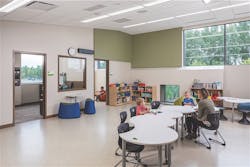Nearly two decades have passed since a breakthrough study by the Heschong Mahone Group concluded that incorporating well-designed daylighting strategies into classroom layouts can improve students’ academic performance in math and reading.
In the succeeding years, designers have incorporated daylighting strategies into many newly built education spaces so that school districts and higher-education institutions could capture the academic and environmental benefits that natural light can provide.
Those benefits may be harder to harness in existing school facilities that were designed in an era when daylighting was considered to be an afterthought or even counterproductive to controlling heating and cooling costs.
But daylighting technique are available to facility managers seeking to retrofit older schools by adding windows and skylights to the spaces where the sun doesn’t shine.
That’s what will be happening over the next several years in the Canyons school district, based in Sandy, Utah. As part of a $283 million bond program approved by voters in 2017, the district will bring daylight to the interiors of 18 elementary older schools by installing large windows and skylights.
“The big reason for doing this is that kids do better with natural light,” says Canyons District Facilities Director Rick Conger. “Most of these classrooms just have no natural light at all.”
That’s because many of Canyon’s campuses, inherited from the Jordan district when Canyons broke away to form its own school system in 2009, were constructed in the 1960s and 1970s when open-classroom designs were a popular trend.
Constructing schools with fewer walls was meant to enhance collaboration among teacher and students. It also lowered construction costs, an appealing feature for school systems driven to build classroom space quickly to accommodate the mushrooming numbers of Baby Boomers.
The classrooms in these schools were divided by bookshelves or other partitions instead of walls, and daylight could be filtered through the school. But over the years, the district says, open classrooms lost favor as the noise from adjacent spaces became a distraction for students.
In the intervening years, many of the open classrooms spaces have been retrofitted with permanent walls. That helped eliminate noises and other distractions that inhibited learning, but the unintended effect was that it prevented fresh air and daylight from reaching interior classrooms.
Since the beginning of the 21st century, educators and designers have more fully embraced daylighting strategies in school facilities as studies have provided evidence of the academic and environmental benefits.
In its bond campaign last year, the Canyons district emphasized to voters the research indicating that students in classrooms with well-designed daylighting show significantly better performance in math and reading compared with classrooms with little or no natural light.
The Canyons district also says that adding windows with views of outdoor greenery can lower the stress and mental fatigue of students and improve the productivity of teachers.
Conger says the first phase of daylighting upgrades is scheduled to be carried out this summer at three elementary schools—Park Lane, Silver Mesa, and Brookwood. Canyons has decided to install tubular skylights that capture sunlight on the roof and send it through highly reflective tubes down to classrooms below.
Two to three skylights will be added to each classrooms at the schools; skylights also will be installed in the schools’ media centers.
The key challenge the district faces in installing skylights is determining precisely where to place them, Conger says, so that they don’t interfere with light fixtures, mechanical ducts, electrical conduit or structural elements of the building.
“It’s quite the process,” Conger says. “You have to know exactly where all the duct work is so that you provide accurate directions.”
The skylight systems will be programmable so that sensors can adjust lighting levels based on outside conditions. Teachers also will be able to control lighting to accommodate specific learning activities (e.g., a video presentation) taking place, Conger says.
Adding skylights and controls for electric lighting are two of the three key considerations for daylight harvesting, according to Lighting Retrofit Strategies for California Schools, a guide from the California Lighting Technology Center at the University of California, Davis.
The guide states that retrofitting spaces with tubular daylighting devices may be less expensive than window retrofits “and will provide much better daylight distribution.”
“In spaces with a ceiling, especially a grid ceiling with acoustic tiles, consider installing tubular daylighting devices,” the guide says.
The third key daylighting consideration, the retrofit guide says, is the reflectance of interior classroom surfaces—walls, ceilings, floors, furnishings. Surfaces with higher reflectance enable light to be spread throughout a space.
“Resurfacing walls, floors and ceilings (either with new paint or new panels or tiles) to have a high, diffuse surface reflectance makes interior spaces look brighter while equalizing brightness distributions and reducing glare,” the retrofit guide says.
In the future, Conger says, the Canyons district is likely look at upgrading the interiors of the newly daylighted classrooms with materials and colors that enhance reflectance and minimize glare from direct sunlight.
About the Author
Mike Kennedy
Senior Editor
Mike Kennedy, senior editor, has written for AS&U on a wide range of educational issues since 1999.


